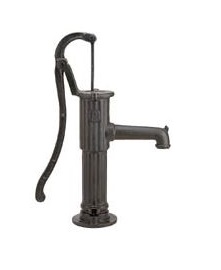HAND PUMP, shallow well
Valid Article
HAND PUMP, shallow well
Definition
Manually powered pump, used to draw water from a maximum depth of 7 metre.
The pump creates a vacuum, which lifts the water by suction. A valve within the piston prevents water from flowing back into the borehole.
Synonym
suction pump
Specifications
There are different kinds of surface hand pumps:
Piston / Membrane pump
Vacuum created by the movement of a piston / membrane.
- Depth (= maximum suction lift): 7 m
- Example of flow rate for a lift of 1.5 m: 0.8 l per stroke, 25 l/min = 1.5 m³/hr (dependent on pump)
- Drawback: this pump often suffers leakage problems
Rotary pump
Vacuum created by a semi- or fully rotating rotor.
EXAMPLE: Japy
- Depth (= maximum suction lift): 7 m
- Example of flow rate 40 - 50 l/min, 2.4 - 3 m³/hr (dependent on pump)
- Construction: cast iron body, brass interior
- Flanges 33/42
- Weight: 10 kg
Instructions for use
(See Preliminary remarks)
To ensure proper installation and operation of a hand pump, proceed according to the instructions provided by the manufacturer.
For more complete information, refer to:
- "Community Water Supply: The Handpump Option", UNDP & World Bank
- MSF Public health engineering, 2nd edition, chapter 2, water supply
- SKAT water lifting, Baumann
- SKAT Handpump types
The need to arrange maintenance and a supply of spare parts must be taken into account from the beginning.
Before the pump is installed, the borehole should be cleaned, disinfected and protected (installing of apron).
Pumping sand will damage the pump and plunger.
Most hand pumps for shallow wells must be primed before first use. The water used for priming must be free of contamination.
To avoid loss of water column, the installation of a non-return valve on the riser pipe is recommended.
Choosing of Hand pumps, main criteria
- Availability of pumps and spare parts. Try to use models available in the region
- Pump´s type of use (family, small community, village, clinic..)
- Depth of well/borehole (the increasing length of the water column requires more effort to draw water, water is heavy)
- Delivery head
- Desired discharge rate
- Quality of water (turbidity, corrosive matter...)
- Price range (spare parts, pump)
- Ease of routine maintenance (are any special tool required, access for maintenance, e.g. replacing seals)
- Ask your technical referent if you have any doubt in choosing and/or operating hand pumps
Maintenance
Maintenance is key: the need to arrange maintenance and a supply of spare parts must be taken into account from the beginning.
- Monthly and tri-monthly checks combined with yearly replacements significantly extend the life of the pump
- Toolkit is needed for maintenance and repair
- It is essential to train pump mechanics and provide them with suitable tools and sufficient spare parts


![[CWATPUMEH0J] MANUAL PUMP fixed Japy type, 40l/mn, 1"¼, unlined](/web/image/product.template/546256/image_256/%5BCWATPUMEH0J%5D%20MANUAL%20PUMP%20fixed%20Japy%20type%2C%2040l-mn%2C%201%22%C2%BC%2C%20unlined?unique=3db1fc3)